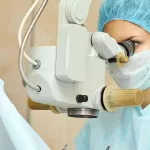
The Role of Genetics in Eye Health
Introduction:
Genetics, the study of heredity and the variation of inherited traits, plays a vital role in eye health. The genetic information we inherit from our parents determines various aspects of our eye structure, function, and susceptibility to eye disorders. Let’s take a closer look at some key genetic factors related to eye health.
1. Genetic Variations and Eye Color
One of the most apparent genetic traits associated with the eyes is their color. The color of our eyes is determined by the presence and distribution of a pigment called melanin in the iris. The genetic variations in the genes involved in melanin production influence eye color. For example, individuals with a higher concentration of melanin tend to have brown eyes, while those with less melanin typically have blue or green eyes.
2. Genetics and Refractive Errors
Refractive errors, such as nearsightedness (myopia), farsightedness (hyperopia), and astigmatism, are common vision problems that affect millions of people worldwide. Genetics significantly contribute to the development of refractive errors.
Nearsightedness (Myopia)
Myopia, or nearsightedness, is a condition where distant objects appear blurry while close-up objects remain clear. Research suggests that genetic factors contribute significantly to myopia development. Individuals with a family history of myopia are more likely to develop this condition themselves.
Farsightedness (Hyperopia)
Hyperopia, or farsightedness, is a condition where close-up objects appear blurry, while distant objects remain clear. Genetics play a role in the development of hyperopia, although it is less understood compared to myopia.
Astigmatism
Astigmatism is a condition where the cornea or lens of the eye has an irregular shape, causing blurred or distorted vision. Genetic factors contribute to the development of astigmatism, although the precise genes involved are not yet fully understood. Astigmatism often occurs in combination with myopia or hyperopia.
3. Genetic Factors in Age-Related Macular Degeneration (AMD)
Age-Related Macular Degeneration (AMD) is a leading cause of vision loss in older adults. It affects the macula, the central part of the retina responsible for detailed vision. Genetics plays a significant role in the development and progression of AMD.
A specific gene known as the Complement Factor H (CFH) gene has been strongly associated with an increased risk of AMD. Variations in this gene can affect the regulation of inflammation and the immune response in the retina, leading to the development of AMD.
In addition to CFH, several other genes, including ARMS2, C3, and CFB, have been identified as risk factors for AMD.
4. Genetic Predisposition to Glaucoma
Glaucoma is a group of eye conditions characterized by damage to the optic nerve, often associated with increased intraocular pressure. While various factors contribute to glaucoma, genetics plays a significant role in determining an individual’s susceptibility to the disease.
Mutations in the Myocilin (MYOC) gene have been linked to an increased risk of developing primary open-angle glaucoma (POAG), the most common form of glaucoma. The MYOC gene is involved in the regulation of intraocular pressure, and certain mutations can lead to abnormal protein buildup, impairing the outflow of fluid from the eye.
Apart from MYOC, other genes, such as Optineurin (OPTN), that contribute to the regulation of cellular processes and the maintenance of healthy optic nerve function have also been associated with an increased risk of glaucoma.
Frequently Asked Questions (FAQs)
1. Can eye color be determined solely by genetics?
Yes, eye color is determined primarily by genetics. Specific genes control the production and distribution of melanin, the pigment responsible for eye color. However, environmental factors, such as lighting conditions and pupil size, can also affect how eye color appears.
2. Is my risk of developing myopia higher if my parents have it?
Yes, having parents with myopia increases the likelihood of developing myopia yourself. The exact genetic mechanisms involved are not yet fully understood, but studies have identified several genes associated with myopia development.
3. Can genetic testing predict my risk of developing AMD?
Genetic testing can provide valuable insights into your risk of developing AMD. Testing for specific genes, such as CFH and ARMS2, associated with AMD can help identify individuals who may be at a higher risk. However, it’s important to note that genetic testing alone cannot predict with certainty whether someone will develop the condition.
4. Are all forms of glaucoma genetically determined?
While genetics can contribute to an individual’s susceptibility to glaucoma, not all forms of glaucoma are solely determined by genetic factors. Other factors, such as age, race, and medical conditions like diabetes, can also play a role in the development of glaucoma.
5. Can genetic factors be modified to prevent eye conditions?
While we cannot change our genetic makeup, understanding genetic risk factors for eye conditions allows for early detection and proactive management. Regular eye exams and adopting a healthy lifestyle can help reduce the impact of genetic predispositions and minimize the risk of developing eye conditions.
6. How will genetic research shape the future of eye health?
Genetic research holds immense potential for advancements in the field of eye health. By identifying specific genetic factors associated with various eye conditions, researchers can develop targeted therapies and interventions. This knowledge may lead to personalized treatment approaches and better outcomes for individuals with eye conditions.





